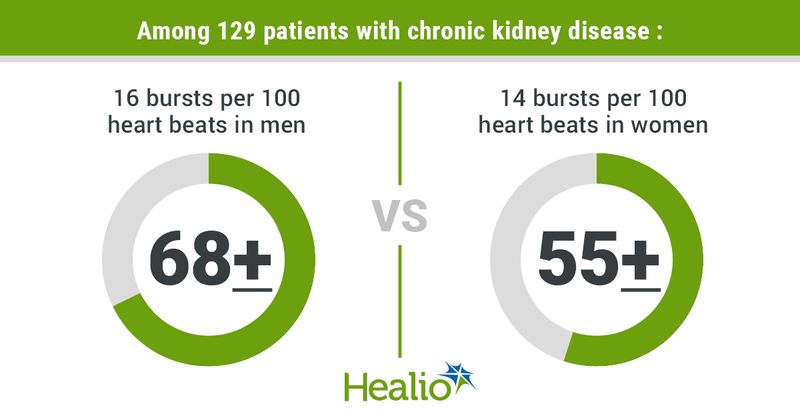Study: Men with CKD may have higher resting muscle sympathetic nerve activity than women
Key takeaways:
- Men had 68±16 bursts per 100 heart beats vs. 55±14 bursts per 100 heart beats for women.
- Researchers found no difference in vascular stiffness between men and women.
Men with chronic kidney disease may have higher resting muscle sympathetic nerve activity than women but show no difference in vascular stiffness, according to study results.
“Although it is well established that [sympathetic nervous system] SNS activity and vascular stiffness are substantially elevated in CKD, prior studies have primarily been performed in men,” Matias G. Zanuzzi, MD, MS, of the division of renal medicine at Emory University School of Medicine in Atlanta, and colleagues wrote. “Less is known about SNS regulation in women with CKD, and whether sex differences in neural and vascular function exist within CKD remains unknown.”

Researchers enrolled 129 patients with CKD stages 3 and 4 to investigate the relationship between sympathetic activity and arterial stiffness based on gender. Overall, 96 men and 33 women were included in the study. Investigators measured carotid-to-femoral pulse wave velocity and resting muscle sympathetic nerve activity during two separate study visits.
Men had higher resting muscle sympathetic nerve activity vs. women, according to the study; specifically, men had 68±16 bursts per 100 heart beats vs. 55±14 bursts per 100 heart beats for women (P = .005).
Researchers found no correlation between resting muscle sympathetic nerve activity and carotid-to-femoral pulse wave velocity, suggesting factors other than neural mechanisms could influence the progression of vascular stiffness in CKD, particularly in women. Additionally, there was no significant variance in carotid-to-femoral pulse wave velocity between groups.
“The current findings shed new light on sex differences in neural and vascular function in CKD, a population at substantially higher risk of cardiovascular mortality,” the researchers wrote. “Future research should investigate the mechanisms underlying sex differences in neurocirculatory control in CKD to develop novel therapies to improve clinical outcomes in this high-risk patient population.”

